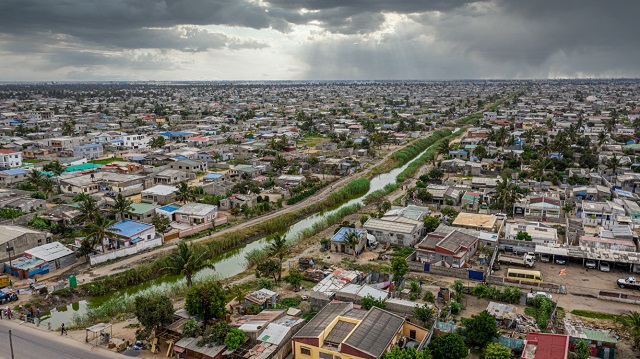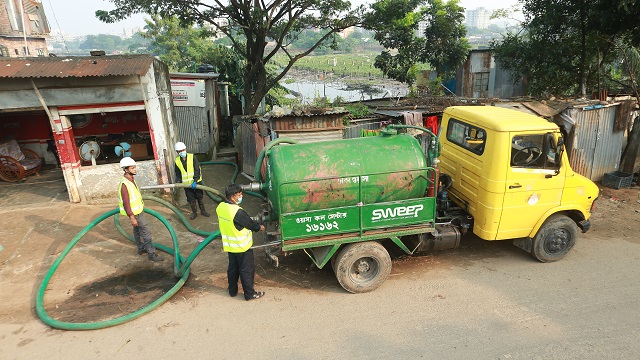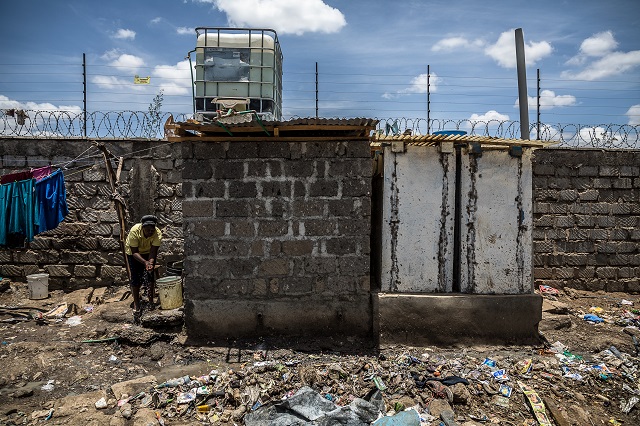
Along the Ngong River in Mukuru, one of Nairobi’s slum neighborhoods and home to more than 100,000 people, residents face a dual threat when the rains come. First, the river rises, flooding into streets and houses. Then the water reaches the sewer lines. The overcapacity, inefficient, poorly maintained pipes often burst, spilling raw sewage into the community.
With climate change, this is happening more frequently and more intensely. From Kenya to the Philippines, heavy rainfall events have wreaked havoc at record levels in recent years. Vast segments of many cities are unable to cope. At the best of times, residents are forced to wade through contaminated waters to get to work and school. At worst, homes are destroyed, families displaced and lives lost.
Climate change is bringing extreme shifts in the opposite direction too. In Zimbabwe, the COVID-19 pandemic coincided with the worst drought in years. Families in the city of Bulawayo resorted to sleeping overnight in water queues, hoping to obtain enough water for daily needs yet complicating social distancing guidelines.
In traditional environmental management, sanitation is not widely considered a climate change issue. Yet, as we are seeing across cities in Africa and Asia, rampant pollution, droughts and floods are together undermining development of urban economies and the wellbeing of their populations. Conversely, sanitation can be a crucial driver to mitigate climate-related disasters and improve quality of life in cities.
WRI and Water & Sanitation for the Urban Poor (WSUP), a non-profit that helps transform cities to benefit the millions who lack access to water and sanitation, support the United Nations’ campaign to change the perception of sustainable sanitation. Thriving urban environments must prioritize the health and socio-economic wellbeing of all their residents in order to become truly resilient and sustainable.
The Poverty Penalty
The urban poor often live in areas that are most exposed to natural disasters, particularly low-lying marshy plains and steep rocky slopes. Having fewer resources – including access to basic municipal services – they also have lower adaptative capacity in some respects. Taking exposure and adaptative capacity together, they face heightened risk.
For example, climate change-driven water stress often leads to water rationing by cities, but this falls much more heavily on the urban poor than other groups. In Maputo, the capital of Mozambique, WRI found one neighborhood where residents pay 13 times more for privately provided water than rates for publicly provided service because piped services do not reach them or were shut off. Safely emptying a pit latrine in Kampala, Uganda, can cost as much as 8% of an average household’s income, incentivizing many to dump directly into drainage channels or rivers instead.
This “poverty penalty” is common across cities in the global south: low-income families must devote a higher proportion of their income to necessities, such as food, energy and water. And they often receive a lower quality of service in return, like water that’s only available for a few hours every few days or is more likely to be contaminated.
If designed to target underserved areas and ensure affordability and payment flexibility, however, sanitation improvements can contribute greatly to a community’s ability to withstand shocks, like the global COVID-19 pandemic, and stresses, like extreme flooding. With the right incentives, sanitation services can also generate jobs and other socio-economic empowerment opportunities.
In a few cities in Bangladesh, WSUP created a public-private partnership called SWEEP, which enables private operators to deliver profitable sanitation waste collection services to households that use septic tanks and pits. It is affordable for low-income households through policies such as cross subsidization. First piloted in Dhaka, the service is now operating in municipalities across the country, benefiting hundreds of thousands of low-income residents.

Sustainability Through Re-Use
Not only are many cities behind on sanitation infrastructure now, but they need to be ready to meet even greater demand in the future. Cities are projected to grow by 2.5 billion people by 2050, which means more demand for water, solid waste and wastewater management – all while dealing with more climate stress.
Designing resilient and sustainable sanitation systems means ensuring they can withstand massive floods and deep droughts, while reducing unreasonable demand for water and promoting waste resource recovery and re-use. It calls for a substantial shift in planning and investment mindsets to embrace closed water systems in modern industrial processes and dwellings. Some contexts have shown that existing solutions, such as simplified sewer systems, which use less water, and dry, on-site sanitation, which does not need to connect to the grid and requires very little water, can be successful in these conditions.
Many cities use sewered sanitation to manage fecal waste, for example. Yet few cities capture their wastewater as a resource. In water-stressed areas, this can also be a crucial solution to reduce water stress. Depending on the context, sanitation systems can achieve sustainability by closing the loop between the inputs and outputs – re-using gray and wastewater, recovering its nutrients, and reducing the excessive distance human waste is transported, often only to be unsafely dumped in rivers or farmlands. For example, a wastewater treatment plant in Namibia has been recycling sewage into drinking water for the past 50 years.
Integration for More Resilient Systems
A shift to sustainable sanitation will require a coordinated effort with other urban services. Often, poor drainage, solid waste management and sanitation create a vicious cycle. Unable to afford safe emptying services, residents will dump untreated waste from pits and septic tanks into drainage channels. Unmanaged trash will clog drains. Contaminated stormwater accumulates in these channels. Heavy rains and uncontrolled flood waters have nowhere to go but over the banks, spreading disease-causing pathogens across cities. A case in point is Kenya, where in 2017 more than 4,000 cholera cases were reported, 70% of which were in Nairobi, which experienced heavy flooding.

In fact, the success of urban climate resilience ultimately depends on this integration. Researchers commissioned by WSUP in Dhaka studied one low-income community where pathogen levels were high throughout the area and modeled the impact of eight different sanitation options. The research found that health outcomes can be significantly improved with well-managed, closed stormwater drains and, when safely managed, fully sealed containment systems. While the findings relate specifically to Dhaka, where open drains are a particular feature of the slums, the research has relevance for other cities, including those at risk from increased rainfall which can exacerbate the spread of pathogens from poorly managed sanitation.
Drainage, solid waste management and sanitation are inextricably linked, and they need to be firmly bundled in policy, planning and management of urban climate change risks.
In Nairobi’s Mukuru neighborhood, such an integrated approach is now being tested. Simplified sewers that use much less water than conventional sewerage are being introduced by the Nairobi City Water & Sewerage Company, the Nairobi Metropolitan Service and a coalition of stakeholders to enable low-income households to connect up to a new main sewer line that will be protected from flooding. Nature-based approaches, like more permeable surfaces, are also helping to soak up excess water and improve natural drainage.
Together, steps like these can help cities to adapt to the realities of climate change while providing immediate improvements to health and wellbeing. We need to do more to ensure that sanitation is included in this debate, and that action is taken to improve the resilience of this core service that is so fundamental to sustainable and thriving cities.
Kariuki Mugo is Director of WASH Sector Support for Water & Sanitation for the Urban Poor.
Steve Metcalfe is the Head of Partnerships & Communications for Water & Sanitation for the Urban Poor.
Jillian Du is a Knowledge and Data Analyst at WRI Ross Center for Sustainable Cities.






